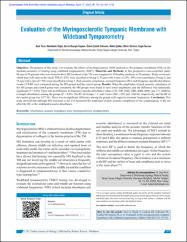| dc.contributor.author | Terzi, Suat | |
| dc.contributor.author | Coşkun, Özgür Zerrin Özergin | |
| dc.contributor.author | Erdivanlı, Özlem Çelebi | |
| dc.contributor.author | Çeliker, Metin | |
| dc.contributor.author | Demirci, Münir | |
| dc.contributor.author | Dursun, Engin | |
| dc.date.accessioned | 2020-12-19T19:48:44Z | |
| dc.date.available | 2020-12-19T19:48:44Z | |
| dc.date.issued | 2017 | |
| dc.identifier.citation | Terzi, S., Coşkun, Ö.Z.Ö., Erdivanlı, Ö.C., Çeliker, M., Demirci, M. & Dursun, E. (2017). Evaluation of the Myringosclerotic Tympanic Membrane with Wideband Tympanometry. Indian Journal of Otology, 23(2), 117-120. https://doi.org/10.4103/indianjotol.INDIANJOTOL_1_17 | en_US |
| dc.identifier.issn | 0971-7749 | |
| dc.identifier.issn | 2249-9520 | |
| dc.identifier.uri | https://doi.org/10.4103/indianjotol.INDIANJOTOL_1_17 | |
| dc.identifier.uri | https://hdl.handle.net/11436/2153 | |
| dc.description | WOS: 000404112800013 | en_US |
| dc.description.abstract | Objective: the purpose of this study is to evaluate the effects of myringosclerosis (MS) localized to the tympanic membrane (TM) on the mechano-acoustics of hearing using wideband tympanometry (WBT). Materials and Methods: in this prospective case-controlled study, 86 ears of 54 patients who were found to have MS localized to the TM were compared to 40 healthy eardrums in 20 patients. Thirty-seven ears which had a MS ratio to the whole TM of < 25% were classified as Group 1, 33 ears with a ratio of 25%-50% were classified as Group 2, and 16 ears with a ratio of > 50% were classified as Group 3. Peak acoustic compliance, resonant frequency (RF), and frequency-specific absorbance results of WBT were compared among the MS groups and the control group. Results: When the amplitudes of peak acoustic compliance of the MS groups and control group were compared, the MS groups were found to have lower amplitudes, and the difference was statistically significant (P < 0.05). There was no difference in frequency-specific absorbance values (250, 500, 1000, 2000, 4000, 8000, and 375- 2000 Hz averaged absorbance) among the groups (P > 0.05). the RF of Groups 1, 2, and 3 were 1062, 1154, and 1166 Hz, respectively, and the RF of the control group was 1077 Hz. There was no significant difference among the groups with regard to resonant frequencies. Conclusion: This study showed that although MS localized to the TM decreased the amplitude of peak acoustic compliance of the tympanogram, it did not affect the RF or the wideband acoustic absorbance. | en_US |
| dc.language.iso | eng | en_US |
| dc.publisher | Wolters Kluwer Medknow Publications | en_US |
| dc.rights | info:eu-repo/semantics/closedAccess | en_US |
| dc.subject | Absorbance | en_US |
| dc.subject | Acoustic impedance tests | en_US |
| dc.subject | Myringosclerosis | en_US |
| dc.subject | Tympanometry | en_US |
| dc.title | Evaluation of the myringosclerotic tympanic membrane with wideband tympanometry | en_US |
| dc.type | article | en_US |
| dc.contributor.department | RTEÜ, Tıp Fakültesi, Cerrahi Tıp Bilimleri Bölümü | en_US |
| dc.contributor.institutionauthor | Terzi, Suat | |
| dc.contributor.institutionauthor | Coşkun, Özgür Zerrin Özergin | |
| dc.contributor.institutionauthor | Erdivanlı, Özlem Çelebi | |
| dc.contributor.institutionauthor | Çeliker, Metin | |
| dc.contributor.institutionauthor | Demirci, Münir | |
| dc.contributor.institutionauthor | Dursun, Engin | |
| dc.identifier.doi | 10.4103/indianjotol.INDIANJOTOL_1_17 | |
| dc.identifier.volume | 23 | en_US |
| dc.identifier.issue | 2 | en_US |
| dc.identifier.startpage | 117 | en_US |
| dc.identifier.endpage | 120 | en_US |
| dc.relation.journal | Indian Journal of Otology | en_US |
| dc.relation.publicationcategory | Makale - Uluslararası Hakemli Dergi - Kurum Öğretim Elemanı | en_US |


















